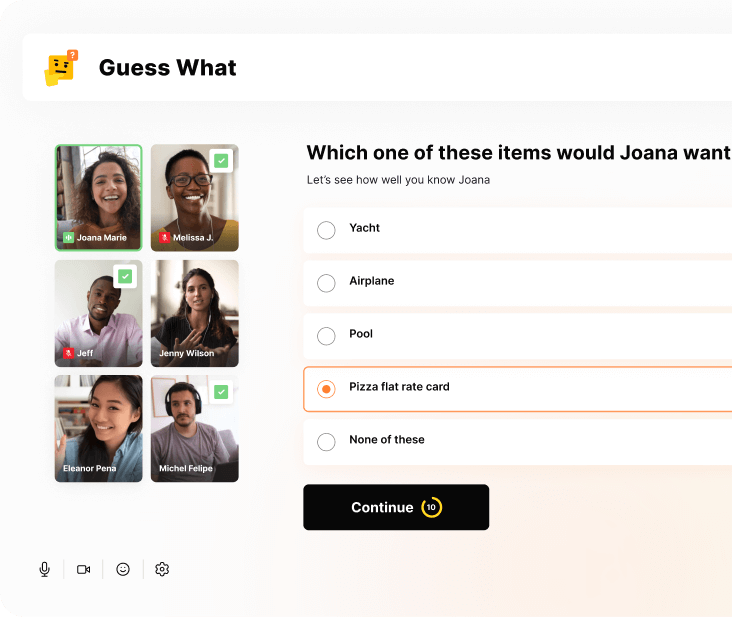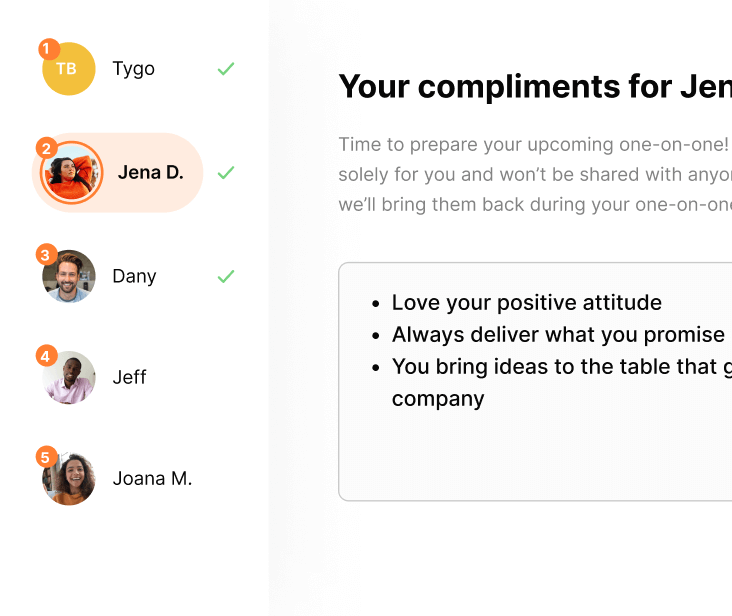Back to Blog
8 mindfulness team building activities for (remote) work
When the topic of mindfulness comes up, many associate it with a yogi meditating in a quiet environment. While yogis are certainly part of mindfulness culture, mindfulness goes far beyond that.
Studies show that mindfulness in the workplace can reduce turnover and resolve conflicts. At the same time, it positively influences performance and innovation. All the more reason to invest in mindfulness at work.
If you'd like to dive deeper into team building, continue reading our other articles:
- The top free team building activities to do with your employees
- Software providers to help you build your best team
- Team building ideas for virtual teams
- Exercises to work on leadership skills
The two dimensions of team mindfulness
Mindfulness, in general, has two components:
- Purposefully bringing attention to the here and now.
- Being open to experiences without judging.
At work, most of us probably experience the opposite more often. We are caught up in our daily tasks, complete them on autopilot, and start worrying about the next projects before they are even relevant.
How is mindfulness related to team building?
Recent research shows that a team can develop mindfulness as an entity. That means team mindfulness is a shared perception of how a group works and approaches new tasks.
Too often, we see team working mindlessly: Team members easily lose focus. The workload is distributed unevenly between members or teams, and tasks don’t get done efficiently. In turn, friction evolves, and group members become defensive and judgy.
By practicing mindfulness, that same team could function more like this: Team members stay focused, and meetings are about exploring facts and ideas instead of judging them. A positive team dynamic develops, which reinforces how colleagues interact with each other. As the members observe and apply these patterns, team mindfulness grows.
If you want to give your team a push in the right direction, get active with some mindful team building activities to try at work.
Share fun facts and bond with a team quiz
Have your participants choose from a list of questions they’d like their coworkers to answer about them, before watching as they guess the right answer.
01. Yes
share-fun-facts-and-bond-with-a-team-quiz

Run a guided recognition activity
Have your participants choose from a list of questions they’d like their coworkers to answer about them, before watching as they guess the right answer.
01. Yes
run-a-guided-recognition-activity

Organize a virtual cooking class
Hire a professional chef to help your team cook a delicious lunch or dinner. May be difficult for co-workers with families. To find providers and get tips, read our blog about virtual cooking classes.
02. No
organize-a-virtual-cooking-class

Hire a stand-up comedian
Have your participants choose from a list of questions they’d like their coworkers to answer about them, before watching as they guess the right answer.
02. No
hire-a-stand-up-comedian

No items found
No items found
Table of contents
When the topic of mindfulness comes up, many associate it with a yogi meditating in a quiet environment. While yogis are certainly part of mindfulness culture, mindfulness goes far beyond that.
Studies show that mindfulness in the workplace can reduce turnover and resolve conflicts. At the same time, it positively influences performance and innovation. All the more reason to invest in mindfulness at work.
If you'd like to dive deeper into team building, continue reading our other articles:
- The top free team building activities to do with your employees
- Software providers to help you build your best team
- Team building ideas for virtual teams
- Exercises to work on leadership skills
The two dimensions of team mindfulness
Mindfulness, in general, has two components:
- Purposefully bringing attention to the here and now.
- Being open to experiences without judging.
At work, most of us probably experience the opposite more often. We are caught up in our daily tasks, complete them on autopilot, and start worrying about the next projects before they are even relevant.
How is mindfulness related to team building?
Recent research shows that a team can develop mindfulness as an entity. That means team mindfulness is a shared perception of how a group works and approaches new tasks.
Too often, we see team working mindlessly: Team members easily lose focus. The workload is distributed unevenly between members or teams, and tasks don’t get done efficiently. In turn, friction evolves, and group members become defensive and judgy.
By practicing mindfulness, that same team could function more like this: Team members stay focused, and meetings are about exploring facts and ideas instead of judging them. A positive team dynamic develops, which reinforces how colleagues interact with each other. As the members observe and apply these patterns, team mindfulness grows.
If you want to give your team a push in the right direction, get active with some mindful team building activities to try at work.
Team building activities to practice awareness of the present moment
1. Do group meditation
Yes, meditation is the OG mindfulness activity, and there's a good reason this practice has persisted several millennials. The benefits of meditation are manifold and include stress reduction, improved self-awarenesss, increased attention-span and more. All these factors will help your team improve their ability to focus and be present.
To make meditation part of your team building habits, you can:
- purchase a team plan with mental health apps like Headspace or Calm
- sign your team up for live meditation classes with Urban Sports Club (online or offline in selected cities in Europe)
- try a well-being platform like Thrive
- or follow guided meditations on Youtube as a group
2. Hold a gratitude session [in-person or online]
Practicing gratitude is great for learning to appreciate the small and big things in life. The first step to being more grateful is to observe yourself and your surroundings and show appreciation for the things you notice.
To make it a team building exercise, get together and instruct everyone to do a body scan. Start by focusing on different body parts and then going over to the senses. Have everyone share in the group what they noticed they’re grateful for: Maybe a ray of sunshine on their skin? Maybe the smell of food coming from the kitchen? Or maybe it’s just how their back doesn’t hurt as bad today.
Related reading: Our 7 favorite thankfulness team building activities.
3. Declutter your office [in-person or online]
The number one thing keeping you from being present is distractions. A pretty obvious distraction in the workspace is a cluttered office set-up. Take time to get together and clean up the communal areas and desks. You can also purchase some handy office organizers beforehand to ensure the decluttering efforts are lasting.
If your team is remote, meet up on a virtual conferencing platform and clean up your personal spaces together.
4. Play Ups & Downs [online]
If your team struggles to focus on their tasks, they could lack purpose and motivation. Low participation leads to bad collaboration, and a lot of work and conversations have to be repeated because people aren’t present.
Ups & Downs is a trivia-like activity that teaches your teammates more about each other’s motivators. Learning what drives your colleagues helps your team align and focus on what matters. Try it now on Gomada.
5. Do a blind drawing exercise [in person or online]
Contrary to what the name might imply, this exercise doesn't require you to sketch blindly. To play, one person explains an image to the rest of the group, who then try to draw what the “explainer” is describing.
The game is great for practicing focus, as participants have to explain and draw purposefully. It’s also a lot of fun to see how the same instructions can create some wildly different imagery.
Team building activities to practice openness and acceptance
6. Hold a design thinking workshop [in-person or online]
Design thinking is a creative approach to problem-solving. At its core, design thinking is about building a product for the people who use it by including them and their needs in the creation process. It helps teams to be open and curious by encouraging them to ask questions and follow an iterative process:
- Emphasize – develop an understanding of your users
- Define – state your users’ needs and problems
- Ideate – challenge assumptions and create ideas
- Prototype – build a first model
- Test

To hold a design thinking workshop, you don’t have to be a designer or build a product; you can also innovate a specific part within your product or for an imaginary one. Learn more about how to hold this creative mindfulness team building workshop here, or start with this beginner’s guide to design thinking.
7. Have an open dialogue [in person or online]
If your team struggles to keep an open mind at work, whether it’s about tasks, team members, or anything else, your best bet may be to sit down together and have an open conversation. Learn about what holds them back and make an honest effort to create change.
While this may sound intimitating, you can find good resources online on:
- how to encourage open communication
- ways to help your team be open to change
- how to overcome unconscous bias in the workplace
8. See challenges as opportunities by drawing on examples from the past [in-person or online]
Speaking of change, even though mindfulness is about living in the moment, there’s also some value in looking back to practice mindfulness. This is especially true when it comes to overcoming problems.
Hold a session to rewind issues your team encountered in the past and discuss how you’ve overcome them and what everybody learned from them. Such an exercise will help your team view challenges as opportunities and approach difficult tasks more openly going forward.
Related reading: The best problem-solving team building activities for 2022/2023.
Subscribe to get our latest updates
Subscribe to get our latest updates





.jpg)

